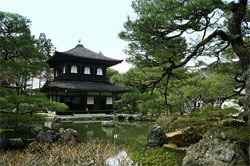Ginkakuji, the Silver Pavilion, was constructed as a retreat by shogun Ashikaga Yoshimasa in 1489 after the destruction of much of Kyoto in the Onin Civil War of 1467. Its rather somber feel contrasts with the dazzling Kinkakuji, the Golden Pavilion, on which it was modeled. The story goes that Yoshimasa ran short of funds to coat the building with silver so that it could reflect the moonlight. Now a Zen temple, the elegant grounds contain a tranquil pond, a stone garden with raised cones, again to reflect moonlight, and a moss garden all designed by master gardener, Soami.

History
Ginkaku-ji, like Kinkaku-ji, is regarded as a branch temple of Shôkoku-ji. Its official name is Tôzan (Eastern Mountains) Jishô-ji. The gentle hills that range along the eastern edge of Kyoto are called Higashiyama ("eastern mountains") and from ancient times have been regarded as possessing a feminine gentleness. The frequent subject of poetry, these mountains are a much appreciated part of the landscape of Kyoto. The peak called Nyoigatake (also known as Daimonjiyama) is well known as the site of the bonfire in the shape of the character dai ("great") visible from the city on August 16, during the Bon festival. Ginkaku-ji is located in the foothills of Daimonjiyama. The "Philosopher's Path," named after a favorite stroll of the philosopher Nishida Kitarô (1870-1945) and a famous route for viewing cherry blossoms in spring and fireflies in summer, runs past its front gate.
This area has a long history. The environs of the Shirakawa River running through it have housed settlements since ancient times. Evidence of Jômon-period (ca. 10,000 BC to ca. 300 BC) sites and temples from the Nara period (710-94) have been discovered here. It has also been a favored site for temples, with the Hônen-in and Reikan-ji in the east and Kurodani Konkaikômyô-ji and Shinnyodô in the south. During the Heian period (794-1185) it was, like Kitayama, a site of imperial tombs, crematories, and temples dedicated to the peaceful repose of the dead. In the mid-Heian period the temple Jôdo-ji was built here. Later the Higashiyama palace, which eventually became Jishô-ji, was built on the temple site.
Source
Address
Ginkakuji, 2 Ginkakuji-cho, Kyoto, Japan, 606-8402.



